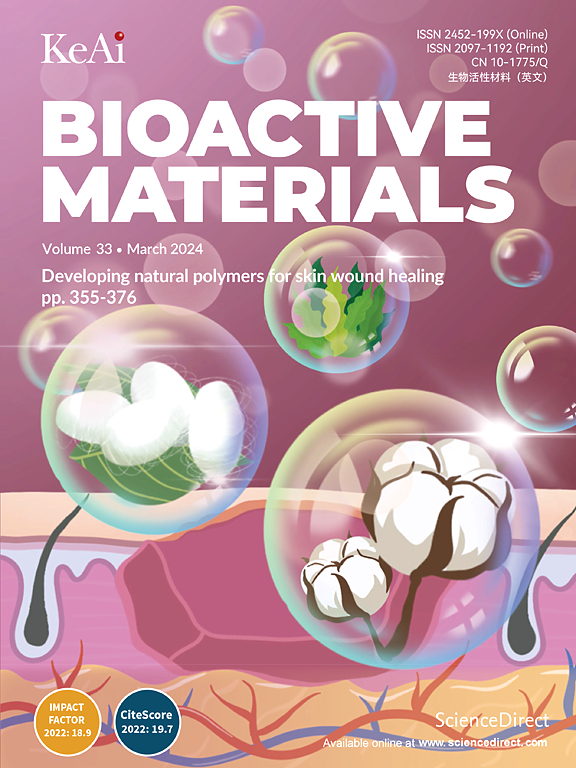A self-hygroscopic, rapidly self-gelling polysaccharide-based sponge with robust wet adhesion for non-compressible hemorrhage control and infected wounds healing
IF 18
1区 医学
Q1 ENGINEERING, BIOMEDICAL
引用次数: 0
Abstract
Uncontrollable non-compressible hemorrhage and traumatic infection have been major causes of mortality and disability in both civilian and military populations. A dressing designed for point-of-care control of non-compressible hemorrhage and prevention of traumatic infections represents an urgent medical need. Here, a novel self-gelling sponge OHN@ε-pL is developed, integrating N-succinimidyl ester oxidized hyaluronic acid (OHN) and ε-poly-L-lysine (ε-pL). Upon application to the wound site, the sponge can rapidly absorb interfacial fluids and undergo a phase transition from sponge to gel. The transformed gel facilitates robust tissue adhesion and achieves synergistic hemostasis by enriching coagulation factors within the sponge phase and providing a barrier effect in the gel phase. The in vitro and in vivo studies revealed that the optimized OHN@ε-pL3 sponge possesses self-gelling capability, tissue adhesion, enhanced coagulation ability, and exhibits excellent biocompatibility and antibacterial efficacy. In hemostasis, OHN@ε-pL3 sponges exhibited reduced blood loss and decreased hemostatic time compared to commercial hemostatic agents, as demonstrated in rat liver, femoral vein, and tail truncation bleeding models. Furthermore, the OHN@ε-pL3 sponge exhibited superior performance in accelerating wound closure and healing of S. aureus-infected wounds. Collectively, OHN@ε-pL sponges represent a promising candidate for medical dressings, specifically for managing uncontrollable non-compressible hemorrhage and traumatic infections.

一种自吸湿、快速自胶的多糖基海绵,具有强大的湿粘附性,用于不可压缩出血控制和感染伤口愈合。
不可控制的非压缩性出血和外伤性感染一直是平民和军人死亡和残疾的主要原因。一种敷料设计的护理点控制非压缩性出血和预防创伤性感染代表了迫切的医疗需求。本研究制备了一种新型自凝胶海绵OHN@ε-pL,它将n -琥珀酰亚胺酯氧化透明质酸(OHN)和ε-聚l -赖氨酸(ε-pL)结合在一起。应用于伤口部位后,海绵可以迅速吸收界面流体,并经历从海绵到凝胶的相变。转化后的凝胶通过在海绵期丰富凝血因子,并在凝胶期提供屏障作用,促进组织牢固粘附,实现协同止血。体外和体内研究表明,优化后的OHN@ε-pL3海绵具有自凝胶能力、组织黏附能力、凝血能力增强,具有良好的生物相容性和抗菌功效。在止血方面,与商业止血剂相比,OHN@ε-pL3海绵在大鼠肝脏、股静脉和截尾出血模型中表现出更少的出血量和更短的止血时间。此外,OHN@ε-pL3海绵在加速金黄色葡萄球菌感染的伤口愈合方面表现出优异的性能。总的来说,OHN@ε-pL海绵是一种很有前途的医用敷料,特别是用于治疗无法控制的不可压缩出血和创伤性感染。
本文章由计算机程序翻译,如有差异,请以英文原文为准。
求助全文
约1分钟内获得全文
求助全文
来源期刊

Bioactive Materials
Biochemistry, Genetics and Molecular Biology-Biotechnology
CiteScore
28.00
自引率
6.30%
发文量
436
审稿时长
20 days
期刊介绍:
Bioactive Materials is a peer-reviewed research publication that focuses on advancements in bioactive materials. The journal accepts research papers, reviews, and rapid communications in the field of next-generation biomaterials that interact with cells, tissues, and organs in various living organisms.
The primary goal of Bioactive Materials is to promote the science and engineering of biomaterials that exhibit adaptiveness to the biological environment. These materials are specifically designed to stimulate or direct appropriate cell and tissue responses or regulate interactions with microorganisms.
The journal covers a wide range of bioactive materials, including those that are engineered or designed in terms of their physical form (e.g. particulate, fiber), topology (e.g. porosity, surface roughness), or dimensions (ranging from macro to nano-scales). Contributions are sought from the following categories of bioactive materials:
Bioactive metals and alloys
Bioactive inorganics: ceramics, glasses, and carbon-based materials
Bioactive polymers and gels
Bioactive materials derived from natural sources
Bioactive composites
These materials find applications in human and veterinary medicine, such as implants, tissue engineering scaffolds, cell/drug/gene carriers, as well as imaging and sensing devices.
 求助内容:
求助内容: 应助结果提醒方式:
应助结果提醒方式:


